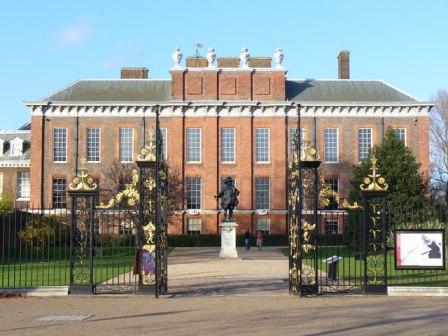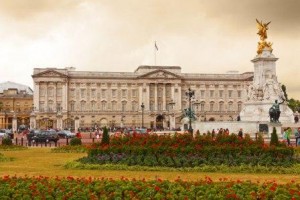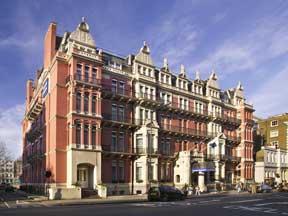
Kensington Palace - © Colin Smith
Kensington Palace is a royal palace located in Kensington Gardens in London, it is still used as an official residence for members of the Royal Family. The palace is synonymous with Diana, Princess of Wales to whom the palace was an official residence. Set in the scenic surroundings of Kensington Gardens, the palace offers visitors the chance to see a historic palace in central London and explore the range of attractions and artefacts inside the grounds. The building dates back to the early 17th century and has been used as a palace for over 300 years. The attractions include the State Apartments, Royal Ceremonial Dress Collection and the King's Gallery which are open to the public.
Attractions
Kensington Palace is located in central London and a popular tourist attraction. The palace has a history stretching back 300 years, it has been a royal residence for members of the Royal Family. Set in the scenic and peaceful surroundings of Kensington Gardens, the site provides a tranquil oasis from the busy city centre. Over the years the palace has undergone a series of changes, alterations and extensions in keeping with the requirements of its royal residents.
Visitors can see the splendid surroundings in Kensington Gardens, located next to the famous Hyde Park, the palace was originally named Nottingham House, in 1689 is became royal property when it was bought by William III and Mary II. The King suffered from severe asthma and this dictated a move away from Whitehall Palace to the cleaner and healthier air of Kensington.
William III died in 1702 and the palace then became the home of Queen Anne. Sir Christopher Wren designed the Orangery for the Queen and a large garden was designed by Henry Wise. There were some large alterations made for George I, the last monarch to live at the Palace was George II. Queen Victoria spent her childhood at the Palace. In more recent years the palace has become well known as the London residence of Diana, Princess of Wales. Today it continues to serve and a residence to several members of the Royal Family.
The Orangery Cafe is located close by to the Palace and offers visitors a range of snacks, light lunches and drinks around the year. There are soups, cakes, pastries and hot meals available, there is also afternoon tea where visitors can enjoy the most quintessentially British experience of enjoying afternoon tea at a Royal Palace.
The State Apartments are a highlight of any visit to the palace there is furniture and paintings from the Stuart-Hanoverian periods along with rooms from the Victorian era and works of art from the extensive Royal Collection. The Highlights include the Kings Apartment with a magnificent collection of Old Masters, Tintoretto and Van Dyck amongst them. The Palace is also the home of the Royal Ceremonial Dress Collection, a unique display of royal, ceremonial and court dress including a selection of dresses worn and owned by HM Queen Elizabeth II and Diana, Princess of Wales.
The Diana, Fashion and Style Exhibition is an exhibition of the late Princess's dresses. During here life the Princess had become a top style icon and there was always much interest in her choice of fashion. The exhibition takes visitors through the fashion development and style changes for the Princess from the early fashion items from the early 1980s to the more sophisticated designs she worn in the early to mid 1990s.
The collection contains some of the most famous fashion items she worn over the years that helped make her a style icon and fashionista favourite. Many of the dresses were made as one off creations for the princess and display a range of creativity, style and talent from top fashion designers from the UK and overseas.
Queen Victoria’s Bedroom is the room in which Queen Victoria went to sleep a princess and awoke a Queen. The room is where the Queen was told in the morning that during the night her uncle the King had died and she was now the Queen at the age of just 18.
The King's Gallery is a gallery that was designed by William Kent to contain the best of the Royal Collection. The room is the longest and the largest of the apartments at the Palace and even today looks similar to its original design for King George I back in 1727. The King's Gallery was used for exercise and for displaying pictures among other uses and contains a copy of Van Dyck’s portrait of Charles I on horseback.
The Royal Ceremonial Dress Collection is a collection of clothing and costumes that have been worn by kings, queens and courtiers dating from the 18th century up until the present day. There are a wide range of fine fabrics, wonderfully ornate dresses that tell visitors the history of high society. From the clothing and costumes on display it is possible to see how fashion in the Royal household has moved at a gentle pace compared to the world of fashion.
Visitors with an interest in history and fashion are likely to enjoy seeing the collection of fashion from the 18th to the 21st centuries. Visitors can see the delicate and ornate designs from dresses from yesteryear including some designs that were very uncomfortable along with grand dresses the likes of which are seldom seen.
The Sunken Garden presents a tranquil and secluded oasis, the garden was planted back in 1908 and helped to change an area that had potting sheds in to a classical ornamental garden. The garden is has modelled itself on the garden found at Hampton Court Palace and represents a popular and celebrated style of gardening that was evident back in the 18th century.
The garden contains a range of flower displays and is terraced with paving and ornamental flower beds. There is an ornamental pond and there are rotational flower displays in the spring and the summer. From April to October there are a range of vivid colours and plants to admire in the garden, it is during this period the garden is at its finest.
In the spring visitors can see the tulips and wallflowers in full bloom whilst in summer there are and pansies bloom, while in the summer months, geraniums and begonias and many others that provide a colourful garden for visitors to admire.
How to Get There
The Palace is accessible by both car and public transport.
By Car:
The palace is located off the A40 Bayswater Road and the A315. It is located to the west of Hyde Park to the west of central London. From the M4 drive until the M4 becomes the A4 and go until the junction with the B325 and turn left on to Gloucester Road, drive until the end of the road and the junction with the A315 and turn left, this will take you towards the entrance for the palace.
Kensington Palace is situated within the London Congestion Charge Zone. Visitors need to factor in the cost of this when visiting by car during the times the charge is applicable. The closest car parks are located on Young Street off Kensington High Street and under the Royal Garden Hotel on Kensington High Street, both are approx 10 to 20 minutes walks from the palace. There are also metered street parking bays on some of the roads close by.
There is no car parking facilities at the palace.
For those using Satellite Navigation systems the postcode to use is W8 4PX.
By Train:
The train stations at Kensington (Olympia) and Paddington are approx 20 to 25 minutes walk away. Visitors can use the Underground to get to stations closer to the palace or alternatively use buses.
By Underground (Tube):
There are a number of Underground stations within walking distance these are Queensway and Notting Hill Gate on the Central Line, they are between 5 to 15 minutes walk away.
The District and Circle lines offer services to High Street Kensington station that is approx a 10 minute walk away.
By Bus:
There are number of local London bus routes that serve the palace area the route numbers include: 70, 94, 148, and 390 to Bayswater Road.
There are also the route numbers: 9, 10, 49, 52, 70, and 452 to Kensington High Street.
Bookings & Tickets
Enjoy a visit to Kensington Palace and combine it with a hotel stay in London to make a great short break. By booking a visit to the palace along with a comfortable hotel stay you can benefit from great value deals. See Kensington Palace Tickets & Booking for more details.
Contact Details
Kensington Palace State Apartments
Kensington Gardens
London
W8 4PX
England
Telephone: +44 (0)20 3166 6311
Fax: +44 (0)20 3166 6310
email: kensingtonpalace@hrp.org.uk
Website: Historic Royal Palaces
Facilities & Information
Opening Times:
For the Palace, Gardens and the Facilities:
Summer Time: March to end of October
Mon to Sun: 10.00 to 18.00 (last admission at 17.00)
Winter Time: November to end of February
Mon to Sun: 10.00 to 17.00 (last admission at 16.00)
It is recommended visitors check all opening and closing times and specific days visits are open when booking to get the latest information & avoid disappointment, as changes can occur.
Further Information:
Admission Prices:
Adult: £12.50 approx, Children: £6.25 approx, Concessions: £11.00 approx, Family Ticket: £34 approx
Map
View Larger Map
For Local Search and Directions see: Kensington Palace Map
Tips & Other Considerations
There may be some variations on the opening hours depending on the time of year and the attraction you wish to see i.e. the palace, the shop or the restaurants. It is wise to double check before going to ensure the attraction you wish to see is open and avoid disappointment.
Remain alert and aware of your belongings at all times when travelling. Make sure your wallet/purse and valuables are hidden away from public view. If you have a bag try to use a shoulder bag with a good quality, strong strap, that is put across your shoulder not on your shoulder making it more difficult for anyone to take your bag.
If you are travelling by car to Kensington Palace ensure you are well prepared with maps and Sat Nav to aid your journey, particularly if you are not familiar with the local area and roads.
If you are looking for car parking near Kensington Palace, ensure you fully understand the rules, regulations & charges for car parks and street parking. The rules & regulations can be complex & confusing if you are unclear, it is wise dot to park there. Parking rules are strictly enforced in central London & can result in fines, clamping and towing of vehicles.
Beware of the car parking charges they can be very expensive anywhere from £4 to £6 or £7 per hour depending on the car park/street parking charges. Visitors can save on car parking if they visit on Sundays, there is no congestion charge and the hourly rates in some car parks are reduced. On Sundays it is possible to get cheaper street parking too with significant savings compared to other times.
If you are travelling by public transport, check for service updates prior to beginning your journey for any delays, disruption or cancellations to services that may impact on your journey. Ensure you have the service timetables for the trains, trams, buses and coaches. Remember when the last services are and ensure you make it to the train/bus/coach stops well in time to avoid missing the service.
Disclaimer: The information given in on this website is given in good faith and to the best of our knowledge. If there are any discrepancies in no way do we intend to mislead. Important travel details and arrangements should be confirmed and verified with the relevant authorities.




